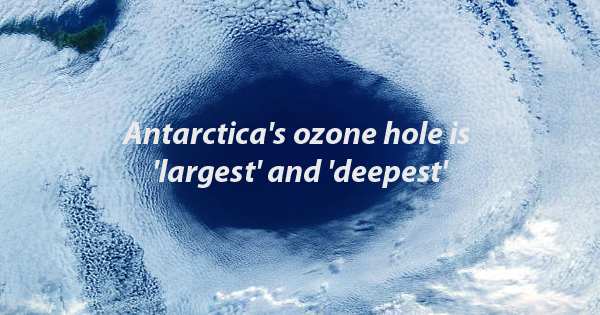The annual ozone hole over the Antarctic is one of the largest and deepest in recent years. The hole in Antarctica’s ozone layer has expanded into its largest recorded size. The ozone hole has been growing rapidly since mid-August 2020, reaching about 24 million square kilometers in early October. It now covers an area of about 23 million km2, on average more than in the last decade, and is spread over most parts of the Antarctic continent.
Scientists have revealed that the Antarctic ozone hole reached its lowest annual peak in 2019 since tracking began in 1982. But like everything else this year – the 2020 update on this atmospheric irregularity brings a clear vision. The WMO’s
Global Atmosphere Watch program works closely with the Copernicus Atmospheric Monitoring Service, NASA, Environment and Climate Change Canada, and other partners to monitor the Earth’s ozone layer, which protects us from
harmful ultraviolet rays.
NASA’s Ozone Watch recorded a minimum of 95 Dobson units in October. Scientists are seeing signs that the 2020 ozone hole has now probably reached its maximum limit. New measurements from the European Space Agency’s
Copernicus Sentinel-5P satellite shows that on October 2 this year, the ozone hole reached a maximum of 25 million square kilometers (about 9.6 million square miles). This puts it at approximately the same force park as the ozone hole of 2018
and 2015, respectively, which recorded peaks of 22.9 and 25.6 million square kilometers, respectively.
The 2020 ozone hole looks the same as in 2013, it was a much bigger hole and it’s been at the top of the pack for the last 15 years or so. In addition to a fluctuating year after year, the Antarctic ozone hole shrinks and increases every year, with the ozone density inside the hole decreasing as the temperature of the stratosphere cools.
When this happens – especially when polar stratospheric clouds form at temperatures below –78 ° C (108.4 ° F) – chemical reactions destroy the ozone molecule in the presence of solar radiation. “We’ve seen ozone persist in the region as sunlight has returned to the South Pole in recent weeks,” Pitch said.
Ozone is a molecule made up of three oxygen atoms and dispersed in a thin layer in the atmosphere. It absorbs ultraviolet radiation from the sun and protects life from this harmful light. The use of chlorofluorocarbons in the 70s and 80s reduced this invaluable gas and created a hole in the layer above Antarctica.
Due to the 1987 Montreal Protocol, these hazardous chemicals came out in phases and the hole is now slowly repairing itself. Year-to-year differences depend on a variety of factors, including polar wind speeds. Claus Jehner, ESA’s Mission Manager for Copernicus Sentinel-5P, commented: Based on the Montreal Protocol and the reduction of anthropogenic ozone-depleting substances, scientists now predict that the global ozone layer will return to normal by about 2050.
















